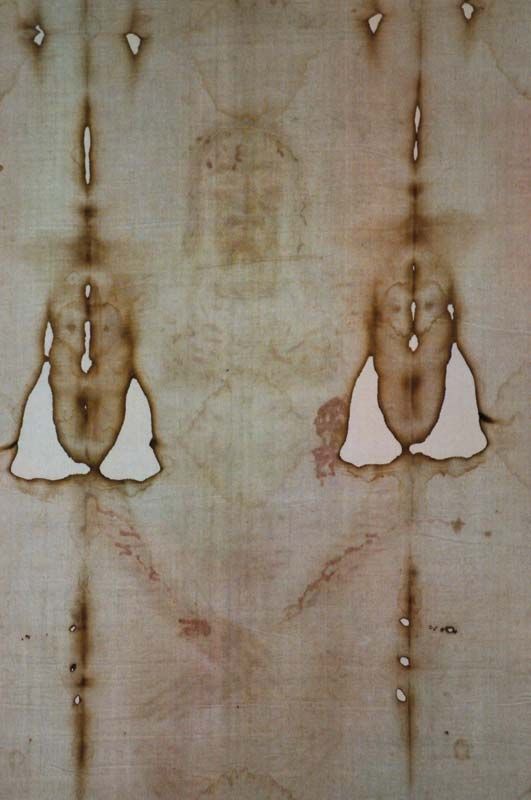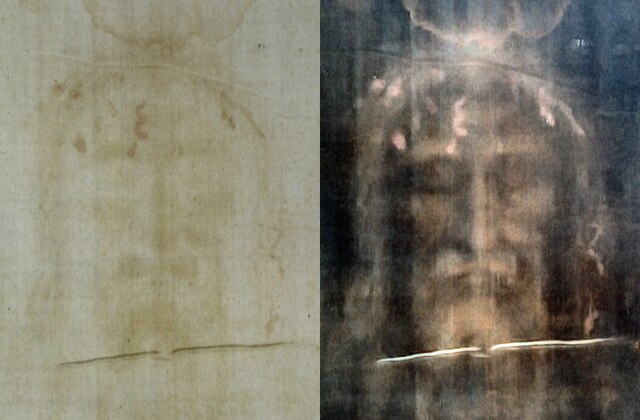The Shroud of Turin stands as one of history’s most enigmatic and controversial artifacts, capturing the imagination of scholars, scientists, and believers for centuries. This extraordinary linen cloth, measuring approximately 14 feet long and 3.5 feet wide, bears a mysterious image of a crucified man that has defied comprehensive explanation.
![]()
The Shroud of Turin showing both positive and negative images. Credit: Wikipedia
In 1898, Italian photographer Secondo Pia made a groundbreaking revelation that would transform our understanding of the Shroud. When he first photographed the cloth, he discovered something extraordinary: the image was dramatically clearer in its photographic negative. This unexpected finding sparked worldwide scientific and religious intrigue, suggesting the image contained information far beyond traditional artistic techniques.

Detailed scientific analysis of the Shroud. Credit: Strange Notions
Numerous scientific teams have meticulously examined the Shroud, employing cutting-edge technologies to decode its secrets. Forensic pathologists have noted astonishing details: the image depicts a man who experienced severe trauma consistent with crucifixion. Detailed anatomical analysis reveals wounds matching biblical descriptions – including scourging marks, a crown of thorns, and nail punctures in the wrists and feet.
The Shroud’s image presents unique scientific challenges. Unlike traditional paintings, the image is extraordinarily superficial, affecting only the topmost fibers of the cloth. Chemical analyses have shown the discoloration results from a complex oxidation process that remains poorly understood. Researchers like Walter McCrone have proposed various theories, from pigment-based explanations to more exotic hypotheses.

The Shroud of Turin preserved in its chapel. Credit: Britannica
In 1988, radiocarbon dating suggested the Shroud originated between 1260 and 1390 CE, seemingly dismissing claims of its authenticity. However, subsequent research has challenged these findings. Some researchers argue that the tested sample might have been from a medieval repair section, potentially skewing the results.
Beyond scientific intrigue, the Shroud represents a profound cultural artifact. It has inspired artistic representations, theological discussions, and continues to fascinate multiple Christian denominations. The Vatican has maintained a nuanced stance, neither definitively confirming nor denying its authenticity.
Today, the Shroud is preserved in a state-of-the-art, climate-controlled environment in Turin, Italy. Ongoing research continues to employ advanced imaging and analytical techniques, maintaining hope that technological advances might ultimately unravel its mysteries.
Whether viewed as a religious relic, an artistic masterpiece, or a scientific puzzle, the Shroud of Turin remains an extraordinary artifact that challenges our understanding of history, technology, and human creativity. Its complex narrative continues to inspire wonder and scholarly investigation.
References:
Shroud of Turin – Wikipedia – link
Shroud of Turin – Britannica – link
Is the Shroud of Turin a Genuine Miracle? – link
Categories: Historical Mysteries, Religious Artifacts, Religious History, Scientific Research, Unsolved Mysteries
Tags: ancient mysteries, archaeological discoveries, Christianity, Historical Relics, Religious Artifacts, Religious History, Scientific Analysis, Shroud of Turin
Religion: Christianity
Country of Origin: France, Italy, Syria, Vatican City
Topic: Religious Artifacts
Ethnicity: Multiple


